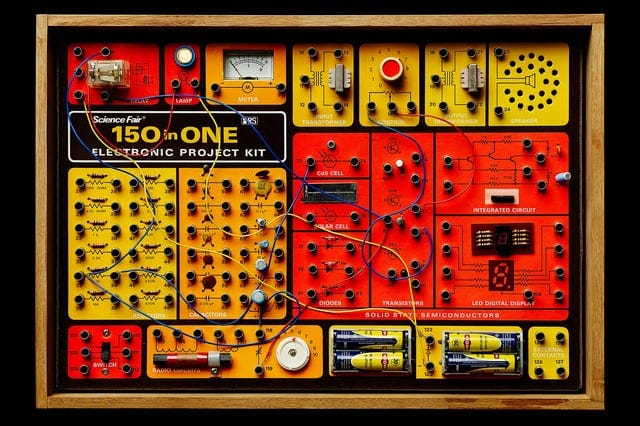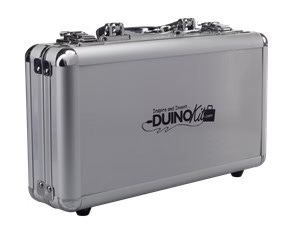An All-in-One Electronics Kit
Dan Alich, a math teacher, is the developer of the DuinoKit line of educational kits
A rather popular Radio Shack product was its 150-in-1 Electronic Project Kit, now considered a vintage item on places like eBay and talked about fondly on Reddit.

Dan Alich, a math teacher from North Carolina, had the idea of building an educational electronics kit somewhat along the same lines. Instead of putting it in a wooden box, he used an aluminum hard case and called it DuinoKit. He has three models - a DuinoKit, Jr. at $149, DuinoKit Educator V3 at $299.00 and a new DuinoKit IoT at $319.00.
This electronics kit could save educators a lot of time having to wrangle microprocessors and connecting different components, just to get started. DuinoKit is a platform for student electronics projects, and much like a laptop, you can open it, close it and store it away easily.
I ran into Dan at Maker Faire Orlando in November. He had driven down to Florida after class ended on Friday. He was a bit tired on Saturday but he manned his exhibit and talked to all kinds of people about the product he makes in his garage in his spare time. I followed up with Dan and interviewed him by email.
1) Can you tell me about yourself? Your interests, where you live, etc.
I am a proud father of four and have lived in the beautiful rural mountains of North Carolina for over 20 years with my wife, children, and a variety of pets. Since childhood, I’ve been fascinated by how things work, particularly electrical and mechanical devices. This curiosity earned me the nickname "MacGyver" during my high school and college years.
My educational journey was unconventional—I struggled in school initially but unexpectedly enrolled in college alongside my then-girlfriend. It was there that mathematics "clicked" for me, ultimately inspiring me to become a mathematics teacher. Beyond academics, I’ve always had a passion for hands-on work, from electronics and crafting to car repairs and home renovations. I like to think of myself as a Jack of all trades, constantly juggling multiple projects and exploring creative solutions.
2) You are a math teacher. Can you talk about what you teach and perhaps why you teach math?
Halfway through college, something unexpected happened—math started to make sense to me. Having struggled with and resisted mathematics for so long, this breakthrough felt transformative. It inspired me to share this newfound understanding with others, leading to my career as a math teacher.
Over the years, I’ve occasionally stepped away from teaching math to explore other interests, including teaching coding and electronics as part of STEM programs in local schools. However, due to limited resources and direction in the rural schools I’ve worked with, I’ve often found myself drawn back to the math classroom. Ultimately, I’ve discovered that helping students grasp and appreciate mathematics is where I can make the most impact.
3) Can you explain DuinoKit and how you got started? Can you say more about what you have online to support your products?
While teaching at an Early College, a former student returned to share her excitement about a project involving an Arduino device. She had used it in college to gather data with a weather balloon. As I listened, I couldn’t help but wonder why she was learning these concepts so late, given that my own children had been exploring similar projects since they were 8 years old. Our home was practically a tech hub—friends even sent their kids over for what we jokingly called "STEM/Computer Camp."
Inspired, I approached my school administration for funding to purchase Arduino starter kits for an elective class. While the course was successful, I noticed a challenge: by the end of the semester, we were left with a scattered assortment of components from the starter kits. Reflecting on my own experience learning electronics with structured Radio Shack kits, where everything was labeled and reusable, I saw a need for a better solution.
This led to the creation of DuinoKit, a project I launched on Kickstarter. DuinoKit offers a self-contained, organized, and user-friendly platform for learning electronics, making it easier for beginners to dive into STEM concepts.
Online, I’ve built a robust library of resources to support DuinoKit users, including tutorials, project guides, and lesson plans, ensuring that both educators and learners can get the most out of their kits.
4) This is your side hustle, of sorts. How much time does it take for you to run a business outside of your teaching job?
When I first started the DuinoKit project, I was dedicating 40–60 hours a week outside of my teaching job to build the business. This included working late nights managing production, collaborating with manufacturers, and finding ways to gain exposure. At one point, I even stepped away from teaching to focus entirely on DuinoKit. However, financial realities and the impact of the COVID-19 pandemic forced me to return to teaching. The pandemic significantly disrupted STEM education and halted in-person trade shows, which had been a major source of sales and visibility for my business.
Today, I spend about 20 hours a week managing DuinoKit, which includes maintaining relationships with manufacturers and suppliers. While this keeps the business running, I know it’s not enough to achieve significant growth. I’m currently exploring new ways to market and expand DuinoKit, particularly strategies that are sustainable alongside my teaching responsibilities.
Operating a tech-focused business in the rural Appalachian Mountains poses unique challenges, as much of the tech-education community is centered in larger cities with more opportunities and resources. Despite these obstacles, I remain committed to finding creative solutions to grow DuinoKit and continue sharing STEM learning with others.
5) What is some of the feedback that you've had from educators who have bought ArduinoKit? What problem does it solve for them? Are you selling it into school makerspaces?
I’ve received great feedback from schools and educators who have used DuinoKit. One recurring challenge I hear about is when a school’s knowledgeable STEM teacher leaves, leaving no one familiar with the tools or curriculum to continue the program. To address this, I’ve provided one-day professional development sessions, during which educators become excited about learning alongside their students and discover resources to integrate into their classrooms. Once teachers grasp Arduino concepts, they’re often inspired to explore creative projects and share that enthusiasm with their students.
DuinoKit addresses several challenges educators face. Traditional starter kits can be daunting, requiring students to learn about resistor color codes, datasheets, and sourcing components before they can even begin a project. DuinoKit’s “plug-and-play” platform eliminates those barriers, allowing students and teachers to dive into electrical engineering concepts quickly and successfully. This approach fosters faster student engagement and builds confidence, which is crucial for sustaining interest in STEM learning.
While DuinoKit is being used in some makerspaces, the primary focus has been on helping educators implement STEM concepts in traditional classroom settings. I’ve seen a variety of creative implementations, ranging from guided projects for less inquisitive students to more open-ended explorations for advanced learners. The flexibility and simplicity of the DuinoKit make it a valuable resource for a wide range of educational needs.
6) You showed me your newest kit. Can you introduce it? What's new about it? Can you give an example of student project based on the kit?
Our newest kit, the IoT Kit, is built around the ESP32 microprocessor, which offers a significant upgrade in processing power compared to the Arduino Nano. This kit includes a GPS module and a PIR sensor, expanding the range of projects and experiments students can explore. While setting up the ESP32 is slightly more complex, its added capabilities—such as WiFi and Bluetooth communication—open up exciting opportunities for versatile and interactive projects. Although the WiFi and BT is fairly advanced for a beginner, it allows for much more advanced projects. We currently have a minor revision to the IoT kit that will include the mini-breadboard.
One standout project created with this kit was a WiFi-enabled two-player Pong game, displayed on an 8x8 LED array. This project demonstrated how students can collaborate, apply coding skills, and adapt existing online projects to create something unique. Many student projects begin as online resources but are then customized based on their growing coding knowledge and creativity.
Our biggest challenge with the IoT Kit is developing a comprehensive set of projects and lesson plans to support educators and students. Balancing this with my full-time teaching job has been difficult, especially since my son, who previously contributed to project development and coding, is now focused on his own full-time work. Despite this, we’re committed to expanding the library of resources to ensure the IoT Kit is as impactful and accessible as possible.
You can learn more at DuinoKit.com.





